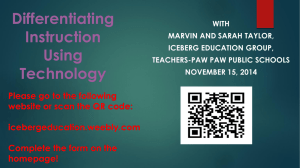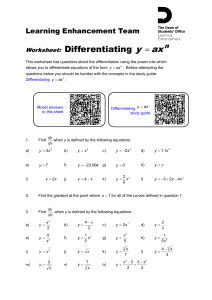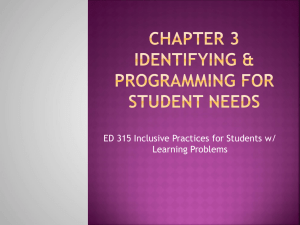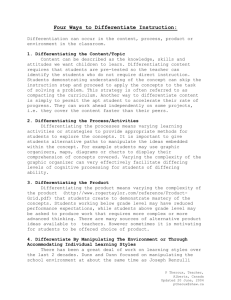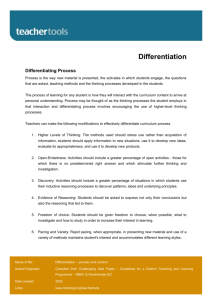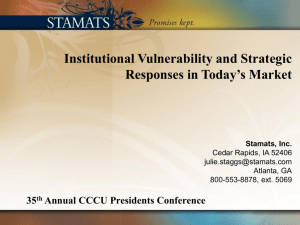Presentation
advertisement
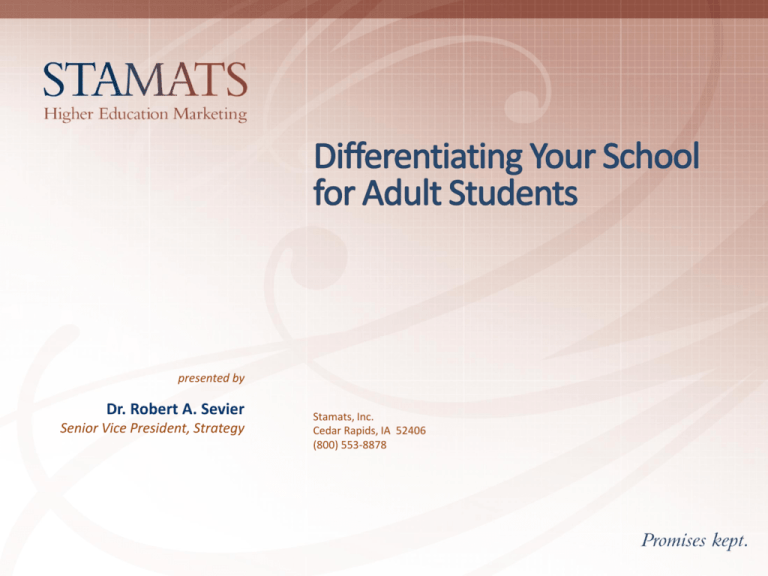
presented by Dr. Robert A. Sevier Senior Vice President, Strategy Stamats, Inc. Cedar Rapids, IA 52406 (800) 553-8878 About Stamats Stamats is recognized and respected as the nation’s higher education integrated-marketing thought leader. Our comprehensive array of innovative services has set the standard for pairing insightful, research-based strategic counsel with compelling creative solutions. We promise our clients the highest level of professional service and attention to detail in the industry because, in the end, we know our success is measured entirely by theirs. Research, Planning, and Consulting ■ Brand clarification and development ■ Image and perception studies ■ Recruiting and marketing assessments, plans, and counsel ■ Tuition pricing elasticity and brand value studies Strategic Creative ■ Institutional, admission ,and ■ ■ ■ ■ 2 | Differentiating Your School for Adult Students | © STAMATS 2014 advancement websites Mobile and social media solutions Recruiting and advancement campaigns and publications Virtual and experiential tours Full media advertising campaigns The Problem Too many schools… Offer the same basic programs as their competitors Taught by the same great faculty Largely deliver the same experience And market themselves the same way As a result Offerings have become more vague Competition has increased Revenues have fallen Margins have become razor thin 3 | Differentiating Your School for Adult Students | © STAMATS 2014 A Working Definition of Strategy The purpose of strategy is to differentiate your school/program from your competitors in ways that target audiences value Let’s unpack this: Differentiation Competitors Target audiences value 4 | Differentiating Your School for Adult Students | © STAMATS 2014 What Is Differentiation? A source of competitive advantage that depends on developing and communicating a quality, attribute, or characteristic that is of value to your customers and not offered by your competitors Competitive advantage Of interest to students, high barrier to entry, high margin Developing Rooted in your mission and vision, based on true marketplace needs Communicating Generating awareness, generating specific program awareness 5 | Differentiating Your School for Adult Students | © STAMATS 2014 Differentiation – continued Quality, attribute, or characteristic Tangible Intangible Of value to customers Based on research Not offered by competitors 6 | Differentiating Your School for Adult Students | © STAMATS 2014 Differentiation – continued Most differentiation strategies depend on one or more of the four Ps: Product Price (almost always a losing strategy) Place Promotion (may give you a temporary edge) The more of the four Ps you can involve in your differentiation strategy, the better off you will be Try to differentiate on those variables that: Are valued by students Have a high barrier to entry 7 | Differentiating Your School for Adult Students | © STAMATS 2014 Relevance From the Perspective of Prospective Students Expecteds Drivers high in relevance, low in differentiation high in relevance, high in differentiation Neutrals Fool’s gold low in relevance, low in differentiation low in relevance, high in differentiation Points of differentiation Source: McKinseyQuarterly.com; modified 8 | Differentiating Your School for Adult Students | © STAMATS 2014 Competitors With whom do you truly compete for prospective students? And other resources: media attention, donated dollars, etc. Generally, three types of competitors: Win from Lose to Split 50/50 (not really your competitors, you beat them up) (not really your competitors, they beat you up) In most cases, you will have your best chance to improve share against the third group: split 50/50 Try to limit your competitors to five 9 | Differentiating Your School for Adult Students | © STAMATS 2014 Competitor Research Secret shopper Compare programs Compare support structures Compare cost Compare financial aid strategies Compare completion rates Your goal is not to be more like your competitors, but different from them in ways students find compelling Where they zig, you need to zag 10 | Differentiating Your School for Adult Students | © STAMATS 2014 Target Audiences Value Based on research, do you understand: What your students seek? Their fears about going (or going back) to college? What motivates? The outcomes they envision? Institutionally centric and audience-centric Caveat emptor and cave emptorum Get inside their heads! 11 | Differentiating Your School for Adult Students | © STAMATS 2014 Strategy is not about doing more or spending more. Strategy about being different in ways your target audiences find compelling. 12 | Differentiating Your School for Adult Students | © STAMATS 2014 Understanding Integrated Marketing Communication …or how IMC, brand marketing, and recruiting all fit together 13 | Differentiating Your School for Adult Students | © STAMATS 2014 Integrated Marketing Communication (IMC) 14 | Differentiating Your School for Adult Students | © STAMATS 2014 Brand Marketing 101 (briefly) A brand is a valued and differentiating promise a college, university, or school makes to its most important audiences to meet a need or fulfill an expectation Perry Forster: “A brand is a promise expressed as a benefit that your target audiences value” Rob Frankel: “Truly successful brands are perceived by the target audience as the best, or even only, solution to a particular need” Big question: What particular need do adult students have? 15 | Differentiating Your School for Adult Students | © STAMATS 2014 What Is the Difference… Between a program that is unique…and a program that is compelling? Unique 16 | Differentiating Your School for Adult Students | © STAMATS 2014 What Competitors Do Well What Stakeholders Value YOUR BRAND PROMISE 17 | Differentiating Your School for Adult Students | © STAMATS 2014 What Audiences Value Direct Marketing (DM) Designed to generate a response Primary direct marketers: – Admissions—want to visit, apply, attend? – Advancement—want to give? Historic DM channels: – Telephone – Postal mail Emergent DM channels: Email Text messaging IM Blogging (and all its permutations) RSS feeds Social networks (social media) 18 | Differentiating Your School for Adult Students | © STAMATS 2014 Internal Communication Consider engaged employees as another channel The key is to keep them informed 19 | Differentiating Your School for Adult Students | © STAMATS 2014 What Is mROI? Measuring return on investment Measurement used to assess the performance of a given marketing initiative (tracking) If we do not evaluate the effectiveness of our marketing and recruiting strategies, they will always be seen as a cost and not an investment Barriers to measurement: Time Money Politics We just don’t want to know (fear?) Poor data collection habits Turf 20 | Differentiating Your School for Adult Students | © STAMATS 2014 The Role of Research Without data, it is only an opinion Research generally falls into two broad categories: Generative Designed to generate messages, ideas, and channels Clarify strategies Evaluative Designed to test effectiveness mROI Well-led organizations use research to reduce uncertainty and clarify options The next few slides are drawn from our annual Adult StudentsTALK™ study and other sources. 21 | Differentiating Your School for Adult Students | © STAMATS 2014 “Deal Makers” for Adult Students Flexibility/Scheduling —“On my schedule, not just when you want to teach.” Convenience —“In-and-out parking; one-stop shop.” Credit for life experience — “Acknowledge what I have already learned through my professional experience.” Accelerated completion — “Time is money.” Valid learning experience — “I’m not here for the social life.” Multiple learning alternatives — “I’m very interested in online options.” Course availability — “The course needs to be there when I can be there.” 22 | Differentiating Your School for Adult Students | © STAMATS 2014 96 percent of adult students would turn to an institutional site for information on enrolling in college 23 | Differentiating Your School for Adult Students | © STAMATS 2014 More than 50 percent of today’s adult students are stealth prospects until application 24 | Differentiating Your School for Adult Students | © STAMATS 2014 College Selection Criteria: Master or Professional Degree Students Which factor is most important to you? n=305 18% Cost to attend Quality of my preferred major or field of study Accreditation of the degree program Flexibility of class scheduling/times Job placements, income increases, or advancements Academic reputation Faculty are good teachers and mentors Online learning options Location is convenient to home or work Time to degree completion Amt of financial aid, including scholarships Specializations or concentrations offered College is known and respected within community Quality of academic facilities Internships/Assistantships provide academic credit College ranking Small student/faculty ratio Career planning services 11% 11% 9% 7% 7% 7% 6% 5% 4% 4% 3% 2% 2% 2% 1% 1% 1% 0% 25 | Differentiating Your School for Adult Students | © STAMATS 2014 10% 20% 30% Top Adult B.A./B.S. Programs CIP 2008-2012 Code CIP Label Grand Total 52.02Business Administration, Management and Operations 357,363 51.38Registered Nursing 166,543 42.01Psychology, General 99,924 43.01Criminal Justice and Corrections 93,721 24.01Liberal Arts and Sciences, General Studies and Humanities 88,639 52.03Accounting and Related Services 82,673 13.12Teacher Education and Professional Development 81,367 52.01Business/Commerce, General 51,698 30.99Multi/Interdisciplinary Studies, Other 45,592 26.01Biology, General 44,478 Grand Total of All CIP Codes 2,069,898 % of Total Yearly Undergraduate Average Degrees 71,473 17.3% 33,309 8.0% 19,985 4.8% 18,744 4.5% 17,728 4.3% 16,535 4.0% 16,273 3.9% 10,340 2.5% 9,118 2.2% 8,896 2.1% 413,980 Source: IPEDS The top 10 degree programs listed above account for over half (54%) of all baccalaureate degrees awarded from primarily adult serving institutions Note: Because IPEDS data does not include degree completions by student age, institutions that had a high percentage of undergraduate students aged 25 or greater were classified as an adult serving institution. 26 | Differentiating Your School for Adult Students | © STAMATS 2014 14 (or so) Differentiation Strategies for Adults 1. 2. 3. 4. 5. 6. 7. Programming/curriculum Faculty Service and support Transferability Scheduling of classes Time to completion Program delivery options 27 | Differentiating Your School for Adult Students | © STAMATS 2014 8. Location 9. Pricing and financial aid 10. Brand marketing 11. Create meaningful segments 12. Channel preferences 13. Web strategy 14. Social media strategy Cost and Convenience 28 | Differentiating Your School for Adult Students | © STAMATS 2014 Affordable 29 | Differentiating Your School for Adult Students | © STAMATS 2014 #1: Programs/Curriculum There is no greater asset than having programs that: Students value Lead to higher paying jobs Your competitors do not offer If you offer the same programs (the first P), then you must differentiate either on price or place A promotion-based differentiation strategy is not sustainable 30 | Differentiating Your School for Adult Students | © STAMATS 2014 Academic Program Marketability Audit Cost Revenue Quality indicators: Graduation rates by major Student satisfaction score within major Percent of students employed in their major or in graduate school within six months of graduation Demand indicators: Prospective student interest in major Enrollment by major Job and employment trends Percent of top five competitors that offer this major 31 | Differentiating Your School for Adult Students | © STAMATS 2014 Quality/Demand and Net Contribution 32 | Differentiating Your School for Adult Students | © STAMATS 2014 Establish Five Centers of Excellence Centers of excellence are programs which: Offer substantial quality Are undersubscribed (you have capacity) Are high margin Are scalable Lead to higher-paying jobs Are of high interest in the marketplace Students, employers, donors, the media Have an effective champion in place Offer co-branding opportunities Do not have a significant competitor Have a high barrier to entry 33 | Differentiating Your School for Adult Students | © STAMATS 2014 Write a Business Plan for New Majors Four key decision areas: Strategic Marketplace Economic and resource Promotion 34 | Differentiating Your School for Adult Students | © STAMATS 2014 #2: Faculty Adult students value faculty who: Understand the unique needs of adults Are approachable Are emphathetic Are available Are competent Have “real-world” experience (though adult students are tired of that phrase) 35 | Differentiating Your School for Adult Students | © STAMATS 2014 #3: Service and Support There is a saying in the service industry: FedEx fast and Disney friendly It is not about customer service, but rather a complete understanding of the importance of the customer As much processes as people Streamline and integrate processes Train and reward your people 36 | Differentiating Your School for Adult Students | © STAMATS 2014 Individuals Who Demonstrate A high motivation to serve others Enthusiasm The ability to listen A customer-sensitive orientation Flexibility A high degree of initiative—1% better each day A positive attitude Resilience Confidence in themselves and their job Unflappability Did I mention the ability to listen? 37 | Differentiating Your School for Adult Students | © STAMATS 2014 Consider Experience Marketing An organizational commitment to identifying and managing, to a specific end, the key touch points that define an experience that a customer has with a product or service Organizational Strategic Identifying Research-based Managing Purposeful Specific end Begins with the end in mind Touch points Where individuals and elements of the organization “touch” Experience To go or live through, to gain understanding or perspective 38 | Differentiating Your School for Adult Students | © STAMATS 2014 Experience Marketing Define Dissect Design Deploy Determine Define Determine Deploy 39 | Differentiating Your School for Adult Students | © STAMATS 2014 Dissect Design Manage Your Academic Experience We discovered, based on research with adult students, that the academic experience comprises 14 or so sub-experiences: Classroom experience Advising Availability/flexibility of classes Technology Facilities—smart classrooms Faculty commitment to teaching Faculty mentorship Internships—co-op Transfer friendly (both to and from) Job placement (starting salary implied) Variety of classes within the program (can customize program) Graduate school placement Library (coffee bar, study space, connectivity) Registration How well are you managing each of these sub-experiences? 40 | Differentiating Your School for Adult Students | © STAMATS 2014 Remember… Many adult students are barely in school It doesn’t take much for them to disengage 41 | Differentiating Your School for Adult Students | © STAMATS 2014 #4: Transferability Programs that well-serve adults make it as easy as possible for students to transfer in…and out Transfer ombudsmen Knowledgeable Powerful Empathetic Generous and fast acceptance of credits Watch out for blanket “credit for life experience” Look at: Baruch College, the University of California, Missouri State University 42 | Differentiating Your School for Adult Students | © STAMATS 2014 #5: Scheduling of Classes When adult students think of class scheduling, one word comes to mind: Flexibility Not only do they value a variety of scheduling options, they expect to have great latitude about choosing options that work best for them At certain times of the year, a student may want evening classes; at other times they want classes in the late afternoon They want the ability to choose 43 | Differentiating Your School for Adult Students | © STAMATS 2014 #6: Time to Completion Credit for life experience Easy transfer of credits Approachable core curriculum Aggressive sequencing of classes Few pre-requisites Good advising 44 | Differentiating Your School for Adult Students | © STAMATS 2014 #8: Location When considering location, adult students look at: Safety Traffic flow/drive time Parking Availability of amenities Coffee shop, wireless, a place to stash their books, backpacks, kids Are the facilities modern, clean, well-lit? Will the majority of their classes be taught in one spot or must they navigate a large campus? Have you established a sense of “place” for adult students? 47 | Differentiating Your School for Adult Students | © STAMATS 2014 #9: Pricing and Financial Aid Adult students, like all other students, are deeply concerned about college cost Increasingly require financial aid, especially aid that is not comprised largely of loans Wary of the word “value.” Instead, use the word “affordable” Broad pricing strategy: If you are a brand buy, you should price in the middle of the top third of your competitors If you are a commodity buy, you should price no higher than the middle of the bottom third of your competitors 48 | Differentiating Your School for Adult Students | © STAMATS 2014 #10: Brand Marketing A brand is a valued and differentiating promise a college, university, or school makes to its most important audiences to meet a need or fulfill an expectation Has four foundation stones: 1) Importance; 2) Believability; 3) Distinctive; and 4) Emotionally engaging Four steps: Make a brand promise (strategic) Communicate your brand promise (tactical) Live your brand promise (experiential) Strengthen your brand promise 49 | Differentiating Your School for Adult Students | © STAMATS 2014 Brand Marketing–2 One of the biggest marketing challenges for adult programs is not the budget, but the internal political environment Deep concern about how the brand for adult programs should relate to the brand for the larger university (the super brand) or other entities on campus Suggest you work out a brand architecture that contains a unified brand communication strategy for both the super brand and all sub-brands 50 | Differentiating Your School for Adult Students | © STAMATS 2014 #11: Create Meaningful Segments What is segmentation? The process of defining and sub-dividing a large semi-homogeneous market into clearly identifiable segments having similar needs, wants, or demand characteristics. Its objective is to design a marketing mix that precisely matches the expectations of customers in the targeted segment Why might a segmentation strategy be useful for you? 51 | Differentiating Your School for Adult Students | © STAMATS 2014 Possible Adult Segmentation Variables Traditional variables Geographic VALs (values, attitudes, and lifestyles) State, city, zip, urban, rural, suburban Geocluster Politics Demographic Age, gender, ethnicity, education level Religious preference Benefits sought (better job) Economic Early adapters Household income Maslow Disposable income Academic variables Academic interest Ability Time to degree 52 | Differentiating Your School for Adult Students | © STAMATS 2014 Worksheet: Segmentation Matrix Segmentation Matrix Adult Segments Brand Attributes Sought VALS and Motivations Media Preferences Influencers Adult Segment 1 1. 2. 3. 1. 2. 3. 1. 2. 3. 1. 2. 3. Adult Segment 2 1. 2. 3. 1. 2. 3. 1. 2. 3. 1. 2. 3. Adult Segment 3 1. 2. 3. 1. 2. 3. 1. 2. 3. 1. 2. 3. Adult Segment 4 1. 2. 3. 1. 2. 3. 1. 2. 3. 1. 2. 3. Adult Segment 5 1. 2. 3. 1. 2. 3. 1. 2. 3. 1. 2. 3. 53 | Differentiating Your School for Adult Students | © STAMATS 2014 #12: Channel Preferences–Adults TV Search engine marketing Direct mail Email Radio Visiting third party websites News in your local newspapers and local media sources Social media platforms Magazine advertising Other online digital display advertising on websites you visit Local newspaper advertising Billboards and other outdoor advertising 54 | Differentiating Your School for Adult Students | © STAMATS 2014 Bachelor n=205 42% 31% 32% 23% 20% 21% Master or Professional n=305 35% 36% 29% 24% 18% 23% 22% 21% 13% 13% 16% 10% 11% 11% 11% 13% 7% 9% 55 | Differentiating Your School for Adult Students | © STAMATS 2014 Design the Entire Flow Manage digital-print interface Likely that your web is, or will soon be, your marketing center of gravity 56 | Differentiating Your School for Adult Students | © STAMATS 2014 Message Radial Website Digital Experience Microsite Campus Events Social Media Fewer Key Messages Multiple Channels Virtual Tour Print Materials Direct Marketing Video Advertising 57 | Differentiating Your School for Adult Students | © STAMATS 2014 Campus Visit One Message, Multiple Channels Facilities and environmentals: 1. Buildings and grounds 2. Signage and perimeter marking Constituent relations: 1. Public 2. Alumni and donor 3. Community 4. Business Interactive media: 1. Web 2. Email 3. CD-ROM Direct response: 1. Telephone 2. Postal mail 3. Email Publications, including variable digital printing and print on demand Sponsorships, promotions, publicity, and collaborations Traditional media (advertising): 1. Magazine and newspaper 2. TV/cable 3. Radio 4. Outdoor/out-of-home Media work: Word-of-mouth Internal communications Engaged employees as media 58 | Differentiating Your School for Adult Students | © STAMATS 2014 IF YOUR PRODUCT IS NO GOOD, SOCIAL MEDIA WON’T FIX IT. 59 | Differentiating Your School for Adult Students | © STAMATS 2014 STOP THINKING “CAMPAIGNS.” START THINKING “CONVERSATIONS.” 60 | Differentiating Your School for Adult Students | © STAMATS 2014 Integration 3.0 1.0 - One message, multiple channels 2. 0 - One message, multiple offices 1.0 3.0 One experience, multiple offices 2.0 3.0 61 | Differentiating Your School for Adult Students | © STAMATS 2014 #13: Web Strategy • Key “buttons” students want to immediately see: Special site just for adult students What adult students value on a website – Fast facts – Financial aid – Majors – Sample curriculum/programs – Advising – Outcomes – Talk to other adult students • Interactive and CMS • Easy to fathom URL 62 | Differentiating Your School for Adult Students | © STAMATS 2014 Keys to An Effective Digital Strategy Platforms (sites) are responsive Audience-centric Students have multiple opportunities to build and contribute to community Digital and social media strategies are developed together and linked to your overall brand and recruiting communication strategy Mobile apps Must recognize that students continually transition from one social media site/platform to the next 63 | Differentiating Your School for Adult Students | © STAMATS 2014 John Marshall School of Law–Mobile Application 64 | Differentiating Your School for Adult Students | © STAMATS 2014 #14: Social Media Strategy Many schools struggle with trying to decide how much to invest in social media Some suggestions: Consider social media as just another channel Remember to budget your marketing dollars by media effectiveness: 70% Tested media 20% New media 10% Experimental media The lesson of Kogi B-B-Q 65 | Differentiating Your School for Adult Students | © STAMATS 2014 Next Steps When you have too much to do, ask yourself What matters most? The Pareto Principle (or the 80/20 rule) Juran’s vital few and trivial many It’s hard to focus on a lot Final Q&A 66 | Differentiating Your School for Adult Students | © STAMATS 2014


